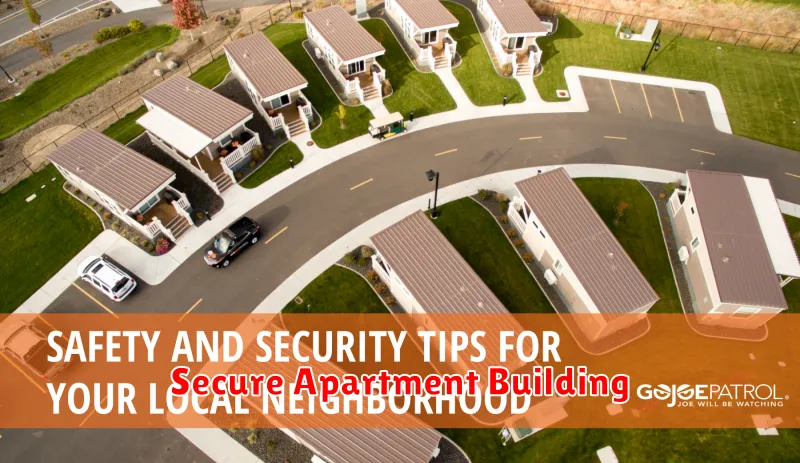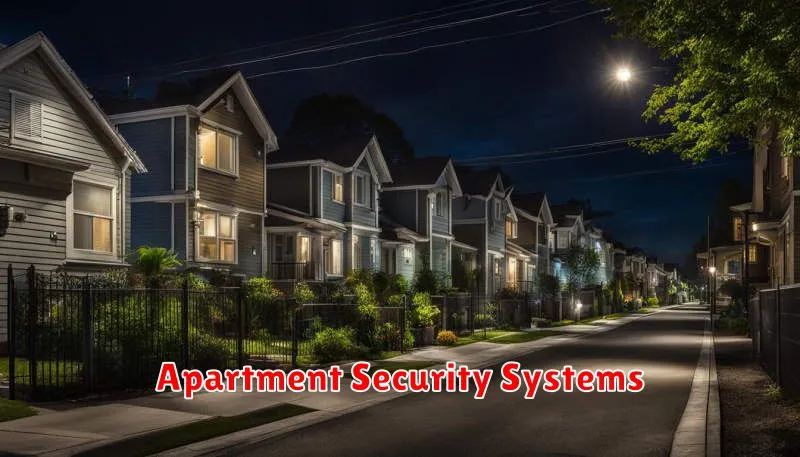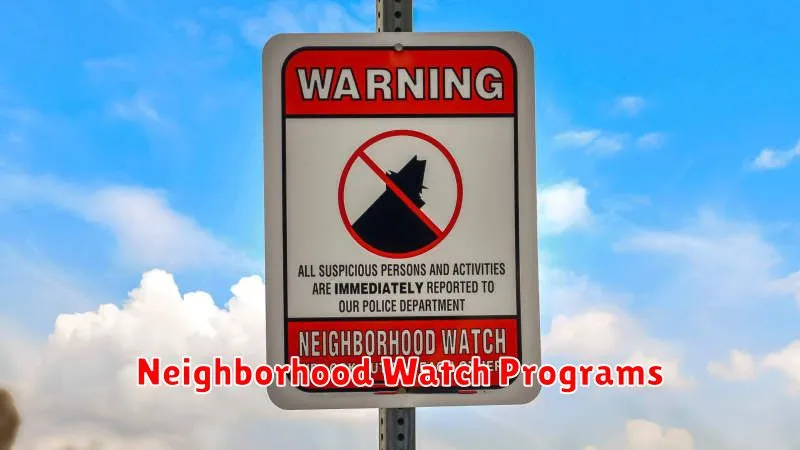Moving to a new city can be an exciting time, but it’s also important to ensure your safety. Choosing the right neighborhood is crucial, and finding a safe apartment within that neighborhood is essential. This article will guide you through the process of evaluating the safety of a potential neighborhood and apartment, helping you find the perfect place that offers both comfort and security. By following these tips, you can make an informed decision and ensure your new apartment is in a safe and welcoming environment.
Researching Neighborhood Crime Statistics
Before you even start looking at apartments, it’s crucial to research the crime statistics of the neighborhoods you’re interested in. This will give you a good idea of the overall safety of the area and help you make an informed decision about where to live. There are several resources available to help you research crime statistics, including:
Police Department Websites: Most police departments have websites that provide access to crime data. This data is often broken down by neighborhood, so you can easily compare the crime rates of different areas.
Neighborhood Watch Groups: Many neighborhoods have active Neighborhood Watch groups. These groups often have websites or social media pages that provide information about crime in the area. You can also reach out to the group directly to get more information.
Online Crime Mapping Tools: There are several online crime mapping tools available that allow you to view crime data on a map. These tools can be helpful for visualizing crime patterns and identifying high-crime areas.
When researching crime statistics, it’s important to consider the following:
- The type of crime: Some crimes, such as property crime, may be more common in certain areas. You should look at the types of crimes that are most prevalent in the neighborhoods you are considering.
- The time period: Crime statistics can fluctuate over time. It’s important to look at data from the most recent period possible to get the most accurate picture of the current crime situation.
- The context: Crime statistics should be considered in the context of the overall community. For example, a neighborhood with a high crime rate may still be considered safe if the majority of the crimes are minor offenses.
Remember that crime statistics are just one factor to consider when evaluating the safety of a neighborhood. Other factors to consider include the overall feeling of the neighborhood, the presence of security features, and the availability of public services.
Checking Local Police Reports and Resources
Before you even start looking at apartments, it’s crucial to check the local police reports and resources. This will give you a good understanding of the crime rates and types of crimes that are common in the area.
Many police departments have websites where you can find crime statistics by neighborhood. You can also request a copy of the crime log, which will list all of the reported crimes in the area. If you’re unsure where to find this information, contact the local police department directly.
In addition to police reports, there are other resources that can help you assess the safety of a neighborhood. For example, you can check the local news website to see if there have been any recent crime stories. You can also talk to people who live in the area to get their insights on the neighborhood’s safety.
By checking local police reports and resources, you can get a better understanding of the crime rates and types of crimes that are common in the area, helping you make a more informed decision about whether or not an apartment is in a safe neighborhood for you.
Visiting the Neighborhood at Different Times of Day
Getting a feel for a neighborhood can be tricky, especially if you are visiting from out of town. One way to do this is to visit the neighborhood at different times of day. This will help you get a sense of how the neighborhood changes throughout the day and who uses it at different times.
In the morning, you might notice that the neighborhood is mostly quiet and peaceful, with families getting ready for their day and people commuting to work. In the afternoon, the neighborhood might become more active, with children playing in parks and people running errands. In the evening, the neighborhood might take on a different character, with people dining at restaurants, attending events, or simply relaxing at home.
Be sure to pay attention to the people in the neighborhood. Do you see a lot of families, young professionals, or students? Do you notice any suspicious activity? The types of people you see can give you a good indication of the neighborhood’s character.
By visiting the neighborhood at different times of day, you can get a well-rounded view of the neighborhood and determine if it is the right fit for you.
Talking to Current Residents
One of the most effective ways to gauge a neighborhood’s safety is by talking to current residents. This direct, firsthand information can provide valuable insights you might not find online or through official statistics. When approaching residents, be respectful of their time and privacy. A simple “hello” and a question like, “Do you feel safe living here?” can open the door to a conversation. Be observant of their body language and tone; their answers will provide valuable clues.
Inquire about common safety concerns, such as crime rates, street lighting, and community policing. Ask if they’ve experienced any incidents or if they have any security measures in place. You might also want to ask about the neighborhood’s overall atmosphere, whether it feels welcoming and safe, and if there are any community initiatives aimed at improving safety.
Don’t be afraid to ask for specific details about potential risks or crime hotspots. Remember, residents are your best source of information about the neighborhood’s true character. Their insights can help you make a more informed decision about whether the apartment you’re considering is in a safe neighborhood.
Evaluating Street Lighting and Security Measures
When assessing the safety of a neighborhood, it’s crucial to evaluate the existing street lighting and security measures. Well-lit streets deter crime by increasing visibility and making potential perpetrators feel more exposed. Observe the quality and frequency of streetlights, ensuring they adequately illuminate sidewalks and parking areas.
Consider the presence of security cameras in public spaces, such as parking garages or building entrances. While cameras don’t guarantee safety, they serve as a deterrent and can assist in investigations.
Look for signs of community involvement in security, such as neighborhood watch programs or residents’ associations that actively promote safety initiatives. This demonstrates a proactive approach to crime prevention, which can enhance a neighborhood’s overall security.
Ultimately, understanding the existing security measures and the level of community engagement in promoting safety can give you valuable insights into the overall safety of your prospective neighborhood.
Proximity to Emergency Services
When looking for a safe neighborhood, proximity to emergency services is crucial. This includes fire stations, police stations, and hospitals. A short distance to these facilities can be a lifesaver in an emergency. Consider the following:
Response Time: The faster emergency responders can reach your apartment, the better. Check response times for different locations within the neighborhood.
Availability: Ensure that the emergency services you need are actually available in the neighborhood. Some areas might have limited resources, so research the availability of hospitals, police stations, and fire stations beforehand.
You can often find this information online or by contacting local emergency services. Remember, a safe neighborhood isn’t just about crime rates; it’s about ensuring access to vital services when you need them.
Assessing Walkability and Public Transportation
A safe neighborhood often boasts great walkability and access to public transportation. Assessing these factors is crucial. Walkability implies you can conveniently walk to grocery stores, pharmacies, parks, and other amenities. It usually means less reliance on cars, which in turn reduces traffic and noise pollution. A well-lit, pedestrian-friendly environment with crosswalks and sidewalks is a sign of a safe neighborhood.
Next, consider public transportation. Reliable bus routes, subway lines, or even ride-sharing services make it easy to get around without driving. The frequency of these services and the convenience of stops near your apartment building are important factors to consider. Well-maintained public transportation options often indicate a neighborhood that prioritizes safety and accessibility for residents.
Checking for Nearby Parks and Green Spaces
Parks and green spaces are more than just places to relax and enjoy the outdoors. They can also be indicators of a safe neighborhood. Well-maintained parks and green spaces are often a sign that a community is invested in its residents’ well-being. They attract people from all walks of life and create a sense of community. This can deter crime, as criminals are less likely to target areas with high foot traffic and a strong sense of community.
When you’re looking for an apartment, take some time to explore the surrounding area. Look for parks that are clean and well-lit, and that have regular events and activities. A park that is neglected or overrun with litter could be a sign that the neighborhood is not well-maintained. If you find yourself in a neighborhood with parks that lack proper lighting and frequent safety concerns, it might be an indication that the neighborhood may not be as safe as you’d like.
Considering School Districts and Educational Opportunities
The quality of the school district is a crucial aspect to consider when choosing an apartment. Not only does it affect the educational opportunities for children, but it also plays a significant role in a neighborhood’s overall safety and community engagement. Researching the reputation of local schools, including their academic performance, extracurricular activities, and student-teacher ratios, is essential. Excellent schools tend to attract families, which often contributes to a safer and more stable neighborhood.
Beyond traditional public schools, consider the availability of other educational resources, such as private schools, charter schools, and community centers. A neighborhood with a diverse range of educational options can be a valuable asset. Look for schools with a strong emphasis on safety, discipline, and character development.
By carefully evaluating school districts and educational opportunities, you can ensure that your chosen apartment is not only situated in a safe neighborhood but also provides a positive environment for your children’s growth and development.
Exploring Local Businesses and Community Involvement
One of the best ways to assess the safety and character of a potential neighborhood is to get a feel for the local businesses and community involvement. Take a walk or drive through the area and observe the shops, restaurants, and community centers. Look for a mix of businesses that cater to different needs, including groceries, pharmacies, and everyday conveniences. This suggests a thriving community with diverse residents.
Pay attention to the presence of community centers, libraries, and parks. These are often signs of a strong community spirit where residents are actively engaged and invested in their neighborhood’s well-being. Additionally, observe the condition of the local businesses and if they appear to be well-maintained and thriving. This can indicate a neighborhood with pride in its appearance and a sense of community.
Engage with local businesses and residents by asking questions about the neighborhood. Ask about safety concerns, community events, and overall neighborhood sentiment. Local business owners and residents are often a valuable source of firsthand information about the area. By getting a sense of the community’s involvement and their opinions, you can gain valuable insights into the neighborhood’s safety and character.
Signs of a Safe Neighborhood

While you can never guarantee complete safety, certain signs can point towards a neighborhood that prioritizes security and well-being. Look for these indicators to gauge the safety of a potential apartment area:
Well-maintained public spaces: Neglected parks, sidewalks, or streetlights can signal a lack of community investment and encourage criminal activity. Conversely, clean and well-lit areas tend to attract residents and deter potential offenders.
Active community involvement: A vibrant neighborhood association, local events, and community initiatives are good signs. These activities foster a sense of belonging and create a network of watchful neighbors.
Low crime rates: Research crime statistics for the area using reliable sources. While isolated incidents can occur anywhere, a consistently low crime rate suggests a safe environment.
Visible police presence: Regular patrols by local law enforcement can deter crime and offer a sense of security. However, remember that an over-reliance on police presence alone isn’t a guarantee of safety.
Good lighting: Well-lit streets and sidewalks discourage criminal activity by reducing opportunities for hiding and providing visibility. A well-lit neighborhood is often a safe neighborhood.
Working security systems: Look for buildings with functional security systems, including cameras, security guards, and locked entrances. This demonstrates a commitment to safety by the building management.
Overall sense of community: You should feel comfortable approaching your neighbors and interacting with them. A strong sense of community creates a network of vigilance and support.
Secure Apartment Building

One of the most important factors to consider when choosing an apartment is the building’s security. A secure apartment building will help you feel safe and comfortable in your home. Look for buildings with features like:
- Security cameras: Cameras are a good deterrent to crime and can help identify suspects if a crime does occur.
- Secured entry: Make sure the building has a locked entrance with a security system, such as a buzzer system or key fob.
- Well-lit hallways and stairwells: Adequate lighting can discourage crime.
- On-site security personnel: A security guard can patrol the building and respond to any incidents.
In addition to security features, you should also consider the building’s location. Look for a building in a safe neighborhood with low crime rates. You can find this information by checking local crime statistics or speaking with residents in the area. You might also want to consider the building’s proximity to police and fire stations.
Finally, when choosing an apartment building, be sure to ask about the building’s security procedures. Ask about things like how the building manages visitor access, what security measures are in place in case of an emergency, and what the building does to prevent crime. By taking these steps, you can help ensure that you are living in a safe and secure environment.
Apartment Security Systems

When looking for a safe neighborhood, it’s crucial to consider the security features of the apartment complex itself. Apartment security systems play a vital role in deterring crime and providing residents with peace of mind. Here’s a breakdown of key features to look for:
Security Cameras: Well-placed cameras serve as a powerful deterrent and can assist in investigations if an incident occurs. Look for complexes with cameras covering common areas, entrances, and potentially parking lots. Some even offer residents access to live feeds or recorded footage.
Controlled Access: Secure entrances with key card readers or buzz-in systems limit access to authorized residents and visitors. Gates, fences, and secure parking garages further enhance security.
On-Site Security Personnel: Some complexes employ security guards to patrol the premises, monitor cameras, and respond to incidents. This offers an extra layer of protection and immediate response in emergencies.
Alarm Systems: Apartments with individual alarm systems allow residents to monitor their unit and receive alerts in case of intrusion. These systems can be integrated with the complex’s security infrastructure for greater effectiveness.
Lighting: Well-lit common areas and parking lots discourage criminal activity. Look for complexes that prioritize adequate lighting at night.
In addition to these features, consider the complex’s security protocols, such as background checks for residents, visitor policies, and emergency response plans.
Neighborhood Watch Programs

Neighborhood watch programs are a great way to make your apartment complex safer and more secure. These programs involve residents working together to keep an eye out for suspicious activity and reporting it to the authorities. Joining a neighborhood watch program can make you feel more connected to your community, and you may even find yourself making new friends.
You can look for signs of a neighborhood watch program in your area by looking for the following:
- Neighborhood Watch signs posted in public areas
- Neighborhood Watch meetings advertised in local newspapers or online
- Information about neighborhood watch programs available at your local police department or community center
If you’re interested in starting a neighborhood watch program in your apartment complex, there are a few things you can do:
- Talk to your landlord about the possibility of starting a program.
- Contact your local police department for information and support.
- Organize a meeting with your neighbors to discuss the program and how it will work.
Neighborhood watch programs are an important part of keeping your neighborhood safe. By getting involved, you can help make your apartment complex a safer place to live.

